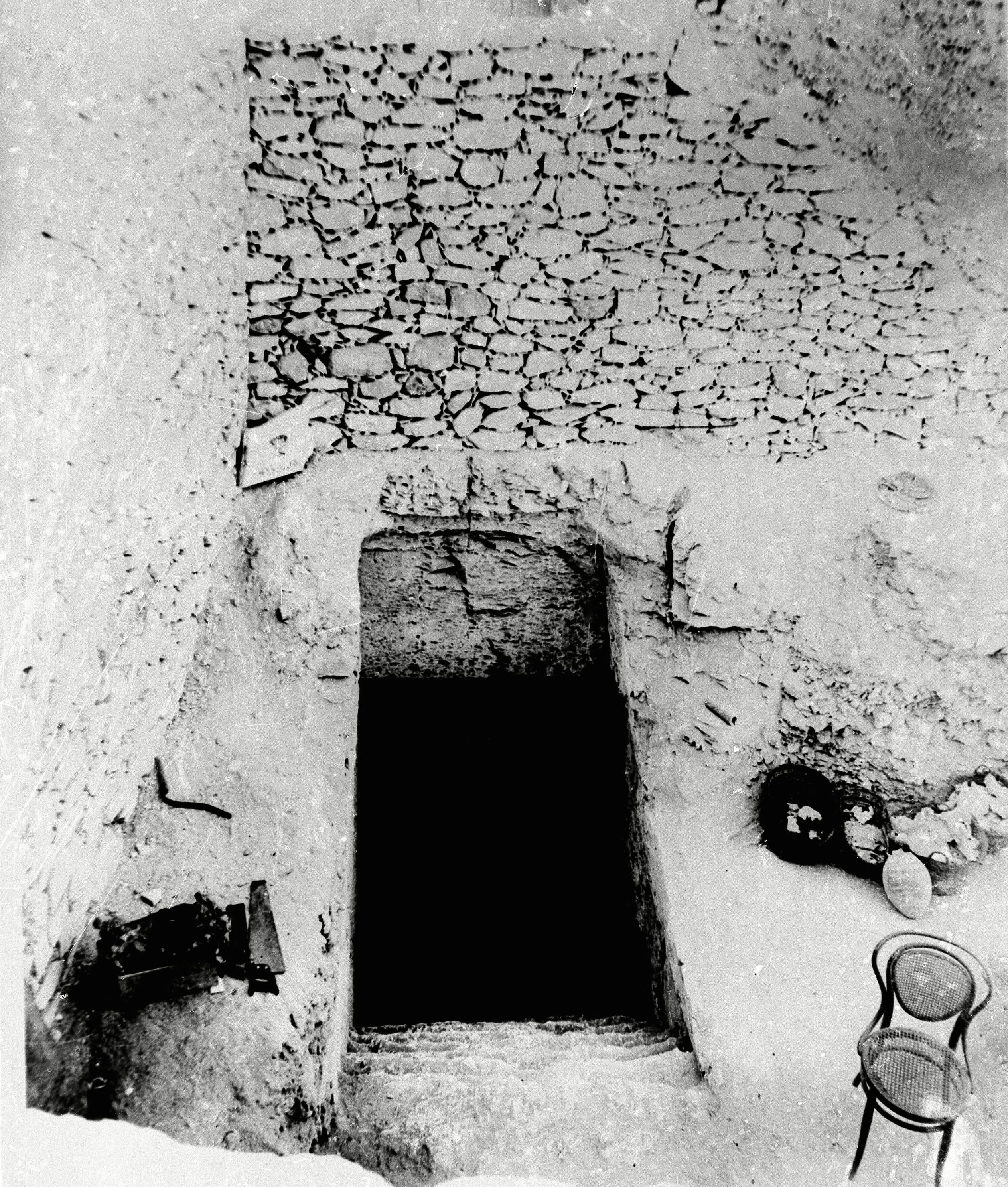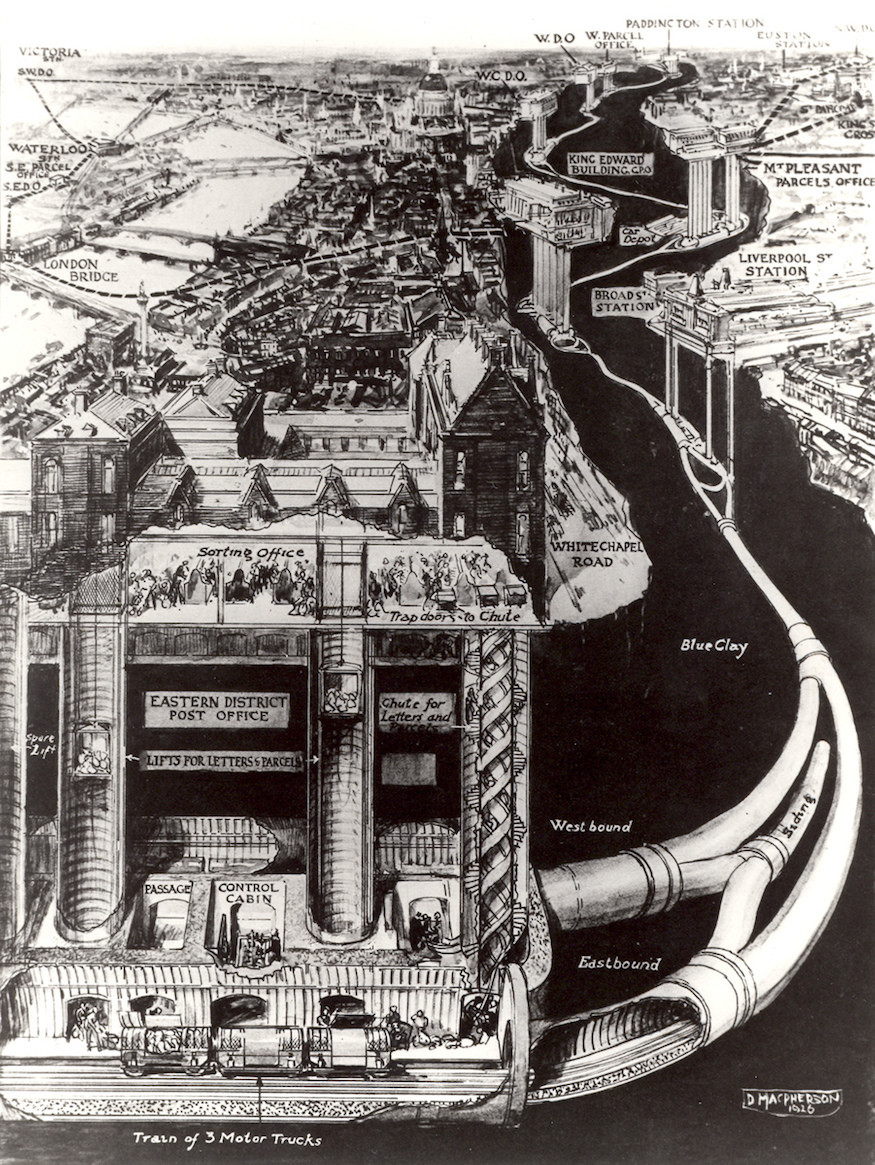In the 1920s artist Douglas MacPherson shone a light into the darkness. He unlocked King Tutankhamun’s sealed tomb and cut-away the London’s Underground to reveal wonders beneath the city’s streets.
Charles Holden (1875-1960) designed more than 40 Tube stations for London Transport, including his revamp of Piccadilly Circus station. Hired by London Transport’s chief executive, Frank Pick, Holden’s brief was to create places in accordance with the design philosophy “fitness for purpose”. Opened in 1906, Piccadilly Station was by the 1920s too small and inefficiently arranged to work well. The surface-level booking hall was hopelessly inadequate.

Map and illustrations showing the new Great Northern, Piccadilly and Brompton underground tube route, linking London stations from Hammersmith to Finsbury Park, 1906.
After a four-year project the new station was unveiled in 1928.
On 15 December 1928, The Spectator magazine surveyed the striking underground ‘ambulatory’:
The new Underground station at Piccadilly Circus was opened on Monday. Only a small red and white awning on the pavement marked the entrance to one of the most remarkable feats of engineering of the century.
Through this station 50,000,000 people will pass every year, as against only a mere 25,000,000 in the old Piccadilly station. A few steps lead down to a low, circular arcade of pale brown marble with a dull white floor, in the centre of which is a supporting pillar. Round it are tall bronze lamps and bronze framed windows in which are displayed such articles of clothing as attract open-mouthed crowds.
Entering from the Haymarket end one sees on the opposite side two large tunnels, one having three and the other two flights of moving stairs with more bronze lamps down the centre – and only in an empty hall can one appreciate the weird effect of a flight of stairs coiling and uncoiling itself from inside a tunnel.
But what about what the passengers and shoppers could not see?
Also working on the London Underground’s building and branding project was artist Douglas MacPherson (1871 – 1851), a member of St John’s Wood arts Club and the Arts Worker’s Guild. MacPherson studied art at the Westminster School of Art. He was an illustrator for William Luson Thomas’s weekly Graphic – renamed the Daily Graphic in 1898 – from 1890 to 1913, working alongside such artists as Sidney Sime, Alexander Boyd, Frank Brangwyn, Edmund Sullivan, Phil May, Leonard Raven-Hill, George Stampa, James H. Dowd, Bert Thomas and F. H. Townsend.
In 1898 the Daily Graphic despatched him to Cuba to cover the war between America and Spain. When King Carlos I of Portugal and Crown Prince Luiz Phillipe were assassinated in Lisbon on 1st February 1908, MacPherson was despatched by the Daily Graphic to cover the story.
In 1919 he left the Daily Graphic and joined The Sphere and later the Illustrated London News. Adventure loomed:
When Lord Caernarvon and Howard Carter team in 1922 went to Luxor and excavated the tomb of King Tutankhamen, Douglas MacPherson was the only artist sent to make watercolour drawings at the opening of the Tomb and the Sarcophagus. His paintings stored in the archives of The Sphere were destroyed during the blitz in World War II.

This is a close up view of the tomb of the King Tutankhamun, who ruled Egypt from 1358 to 1350 B.C.E., seen, in Luxor, Egypt
Treasures Of King Tut 1922, Luxor, Egypt
The Sphere wrote of its trailblazing artist:
The Editor of the Sphere is glad to be able to present to his readers a first impression in colour of the shrine of Tutankhamen, discovered by the late Earl of Carnarvon and Mr. Howard Carter in the spring of this year. This wonderful structure of blue and gold is described by Mr. Howard Carter in his book, The Tomb of Tutankhamen just published by Messrs. Cassell. From the volume we quote the following from the scene which the Sphere’s special artist has depicted above:
‘There before us lay the sealed door, and with its opening we were to blot out the centuries and stand in the presence of a king who reigned three thousand years ago. My own feelings as I mounted the platform were a strange mixture, and it was with a trembling hand that I struck the first blow . . . An astonishing sight its light revealed, for there, within a yard of the doorway stretching as far as one could see and blocking the entrance to the chamber, stood to all appearance was a solid wall of gold . . . We were at the entrance of the actual burial chamber of the king, and that which barred our way was the side of an immense gilt shrine built to cover and protect the sarcophagus . . . Its roof, with cornice top and torus moulding, reached almost to the ceiling. From top to bottom it was overlaid with gold and upon its sides there were inlaid panels of brilliant blue faience, in which were represented, repeated over and over, the magic symbols which would ensure its strength and safety. . . We felt that we were in the presence of the dead king, and must do him reverence . . . Carefully, and as silently as possible, we reclosed the great swing doors.’
Following the excitement of the Tutankhamen discoveries, his next big project was the first Everest expedition. In 1924 he was commissioned to paint in black and white aerial views of the route of ascent from photographs. He also produced the poster for the film show of the expedition.
As well as travel posters, Douglas produced diagrams, maps and guides, no more fabulous than this Cutaway diagram of Piccadilly Circus station from 1928.
The words below the cutaway map of Piccadilly Station told readers:
Piccadilly station, the hub of London’s vast Underground railway system is one of the busiest points in the whole network. It holds the record for the only station in the world with as many as eleven escalators. On each of the tubes, whose tracks cross here, the frequency of service in the ‘rush’ hours rises to forty trains an hour on each line of metals. The station is planned on modern, entirely sub-service lines, with batteries of electrically operated ticket machines, automatic booking office equipment, triples escalators and every device to expedite the flow of passengers.
Would you like to support Flashbak?
Please consider making a donation to our site. We don't want to rely on ads to bring you the best of visual culture. You can also support us by signing up to our Mailing List. And you can also follow us on Facebook, Instagram and Twitter. For great art and culture delivered to your door, visit our shop.











